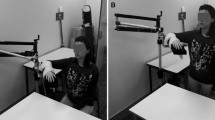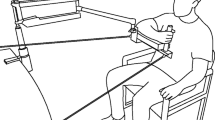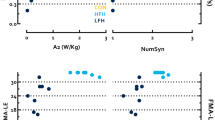Abstract
To better understand how arm weight support (WS) can be used to alleviate upper limb impairment after stroke, we investigated the effects of WS on muscle activity, muscle synergy expression, and corticomotor excitability (CME) in 13 chronic stroke patients and 6 age-similar healthy controls. For patients, lesion location and corticospinal tract integrity were assessed using magnetic resonance imaging. Upper limb impairment was assessed using the Fugl-Meyer upper extremity assessment with patients categorised as either mild or moderate–severe. Three levels of WS were examined: low = 0, medium = 50 and high = 100% of full support. Surface EMG was recorded from 8 upper limb muscles, and muscle synergies were decomposed using non-negative matrix factorisation from data obtained during reaching movements to an array of 14 targets using the paretic or dominant arm. Interactions between impairment level and WS were found for the number of targets hit, and EMG measures. Overall, greater WS resulted in lower EMG levels, although the degree of modulation between WS levels was less for patients with moderate–severe compared to mild impairment. Healthy controls expressed more synergies than patients with moderate–severe impairment. Healthy controls and patients with mild impairment showed more synergies with high compared to low weight support. Transcranial magnetic stimulation was used to elicit motor-evoked potentials (MEPs) to which stimulus–response curves were fitted as a measure of corticomotor excitability (CME). The effect of WS on CME varied between muscles and across impairment level. These preliminary findings demonstrate that WS has direct and indirect effects on muscle activity, synergies, and CME and warrants further study in order to reduce upper limb impairment after stroke.








Similar content being viewed by others
References
Andersson JLR, Sotiropoulos SN (2016) An integrated approach to correction for off-resonance effects and subject movement in diffusion MR imaging. Neuroimage 125:1063–1078
Bates D, Mächler M, Bolker BM, Walker SC (2015) Fitting linear mixed-effects models using lme4. J Stat Softw 67:1–48
Beer RF, Dewald JPA, Dawson ML, Rymer WZ (2004) Target-dependent differences between free and constrained arm movements in chronic hemiparesis. Exp Brain Res 156:458–470
Beer RF, Ellis MD, Holubar BG, Dewald JPA (2007) Impact of gravity loading on post-stroke reaching and its relationship to weakness. Muscle Nerve 36:242–250
Bizzi E, Cheung VCK (2013) The neural origin of muscle synergies. Front Comput Neurosci 7:1–6
Bradnam LV, Stinear CM, Barber PA, Byblow WD (2012) Contralesional hemisphere control of the proximal paretic upper limb following stroke. Cereb Cortex 22:2662–2671
Cheung VCK, Piron L, Agostini M, Silvoni S, Turolla A, Bizzi E (2009) Stability of muscle synergies for voluntary actions after cortical stroke in humans. Proc Natl Acad Sci USA 106:19563–19568
Cheung VCK, Turolla A, Agostini M, Silvoni S, Bennis C, Kasi P, Paganoni S, Bonato P, Bizzi E (2012) Muscle synergy patterns as physiological markers of motor cortical damage. Proc Natl Acad Sci USA 109:14652–14656
Clark DJ, Ting LH, Zajac FE, Neptune RR, Kautz SA (2010) Merging of healthy motor modules predicts reduced locomotor performance and muscle coordination complexity post-stroke. J Neurophysiol 103:844–857
Coscia M, Cheung VCK, Tropea P, Koenig A, Monaco V, Bennis C, Micera S, Bonato P (2014) The effect of arm weight support on upper limb muscle synergies during reaching movements. J NeuroEng Rehabil 11:1–15
Cramer SC, Nelles G, Benson RR, Kaplan JD, Parker RA, Kwong KK, Kennedy DN, Finklestein SP, Rosen BR (1997) A functional MRI study of subjects recovered from hemiparetic stroke. Stroke 28:2518–2527
Devanne H, Lavoie BA, Capaday C (1997) Input-output properties and gain changes in the human corticospinal pathway. Exp Brain Res 114:329–338
Devanne H, Cohen LG, Kouchtir-Devanne N, Capaday C (2002) Integrated motor cortical control of task-related muscles during pointing in humans. J Neurophysiol 87:3006–3017
Devanne H, Cassim F, Ethier C, Brizzi L, Thevenon A, Capaday C (2006) The comparable size and overlapping nature of upper limb distal and proximal muscle representations in the human motor cortex. Eur J Neurosci 23:2467–2476
Dewald JPA, Beer RF (2001) Abnormal joint torque patterns in the paretic upper limb of subjects with hemiparesis. Muscle Nerve 24:273–283
Dominici F, Popa T, Ginanneschi F, Mazzocchio R, Rossi A (2005) Cortico-motoneuronal output to intrinsic hand muscles is differentially influenced by static changes in shoulder positions. Exp Brain Res 164:500–504
Ellis MD, Schut I, Dewald JPA (2017) Flexion synergy overshadows flexor spasticity during reaching in chronic moderate to severe hemiparetic stroke. Clin Neurophysiol 128(7):1308–1314
Ellis MD, Carmona C, Drogos J, Dewald JPA (2018) Progressive abduction loading therapy with horizontal-plane viscous resistance targeting weakness and flexion synergy to treat upper limb function in chronic hemiparetic stroke: a randomized clinical trial. Front Neurol 9:71
Feigin VL, Barker-Collo S, Parag V, Senior H, Lawes CMM, Ratnasabapathy Y, Glen E, ASTRO study group (2010) Auckland Stroke Outcomes Study. Part 1: gender, stroke types, ethnicity, and functional outcomes 5 years poststroke. Neurology 75:1597–1607
Flanders M, Herrmann U (1992) Two components of muscle activation: scaling with the speed of arm movement. J Neurophysiol 67:931–943
Fox J, Weisberg S (2010) An R companion to applied regression, 2nd edn. SAGE, Thousand Oaks
Fridman EA, Hanakawa T, Chung M, Hummel F, Leiguarda RC, Cohen LG (2004) Reorganization of the human ipsilesional premotor cortex after stroke. Brain 127:747–758
Frost SB, Barbay S, Friel KM, Plautz EJ, Nudo RJ (2003) Reorganization of remote cortical regions after ischemic brain injury: a potential substrate for stroke recovery. J Neurophysiol 89:3205–3214
Ginanneschi F, Santo F, Dominici F, Gelli F, Mazzocchio R, Rossi A (2005) Changes in corticomotor excitability of hand muscles in relation to static shoulder positions. Exp Brain Res 161:374–382
Ginanneschi F, Dominici F, Biasella A, Gelli F, Rossi A (2006) Changes in corticomotor excitability of forearm muscles in relation to static shoulder positions. Brain Res 1073–1074:332–338
Grefkes C, Fink GR (2011) Reorganization of cerebral networks after stroke: new insights from neuroimaging with connectivity approaches. Brain 134:1264–1276
Herbert WJ, Powell K, Buford JA (2015) Evidence for a role of the reticulospinal system in recovery of skilled reaching after cortical stroke: initial results from a model of ischemic cortical injury. Exp Brain Res 233(11):3231–3251
Israely S, Leisman G, Machluf CC, Carmeli E (2018) Muscle synergies control during hand-reaching tasks in multiple directions post-stroke. Front Comput Neurosci 12:10
Jenkinson M, Smith S (2001) A global optimisation method for robust affine registration of brain images. Med Image Anal 5:143–156
Jenkinson M, Bannister P, Brady M, Smith S (2002) Improved optimization for the robust and accurate linear registration and motion correction of brain images. Neuroimage 17:825–841
Jenkinson M, Beckmann CF, Behrens TEJ, Woolrich MW, Smith SM (2012) FSL. Neuroimage 62:782–790
Johansen-Berg H, Rushworth MFS, Bogdanovic MD, Kischka U, Wimalaratna S, Matthews PM (2002) The role of ipsilateral premotor cortex in hand movement after stroke. Proc Natl Acad Sci USA 99:14518–14523
Johnson MJ (2006) Recent trends in robot-assisted therapy environments to improve real-life functional performance after stroke. J NeuroEng Rehabil 3:29
Kantak SS, Wittenberg GF, Liao W-W, Magder LS, Rogers MW, Waller SM (2013) Posture-related modulations in motor cortical excitability of the proximal and distal arm muscles. Neurosci Lett 533:65–70
Karbasforoushan H, Cohen-Adad J, Dewald JPA (2019) Brainstem and spinal cord MRI identifies altered sensorimotor pathways post-stroke. Nat Commun 10(1):3524
Kieliba P, Tropea P, Pirondini E, Coscia M, Micera S, Artoni F (2018) How are muscle synergies affected by electromyography pre-processing? IEEE Trans Neural Syst Rehabil Eng 26:882–893
Krabben T, Prange GB, Molier BI, Stienen AHA, Jannink MJA, Buurke JH, Rietman JS (2011) Influence of gravity compensation training on synergistic movement patterns of the upper extremity after stroke, a pilot study. J NeuroEng Rehabil 9:44
Kwakkel G, Meskers CGM (2014) Effects of robotic therapy of the arm after stroke. Lancet Neurol 13:132–133
Kwakkel G, Wagenaar RC, Kollen BJ, Lankhorst GJ (1996) Predicting disability in stroke—a critical review of the literature. Age Ageing 25:479–489
Kwakkel G, van Peppen R, Wagenaar RC, Wood Dauphinee S, Richards C, Ashburn A, Miller K, Lincoln N, Partridge C, Wellwood I, Langhorne P (2004) Effects of augmented exercise therapy time after stroke: a meta-analysis. Stroke 35:2529–2539
Lan Y, Yao J, Dewald JPA (2017) The impact of shoulder abduction loading on volitional hand opening and grasping in chronic hemiparetic stroke. NNR 31(6):521–529
Lang CE, Macdonald JR, Reisman DS, Boyd L, Jacobson Kimberley T, Schindler-Ivens SM, Hornby TG, Ross SA, Scheets PL (2009) Observation of amounts of movement practice provided during stroke rehabilitation. Arch Phys Med Rehabil 90:1692–1698
Loureiro RCV, Harwin WS, Nagai K, Johnson M (2011) Advances in upper limb stroke rehabilitation: a technology push. Med Biol Eng Comput 49:1103–1118
Luo D, Ganesh S, Koolaard J (2014) Predictmeans: calculate predicted means for linear models. http://cran.r-project.org/web/packages/predictmeans/index.html. Accessed 1 Dec 2016
MATLAB (2016). Version 9.1 (R2016b) In: The Mathworks Inc, Natick, Massachusetts
McKiernan BJ, Marcario JK, Karrer JH, Cheney PD (1998) Corticomotoneuronal postspike effects in shoulder, elbow, wrist, digit, and intrinsic hand muscles during a reach and prehension task. J Neurophysiol 80:1961–1980
McMorland AJC, Runnalls KD, Byblow WD (2015) A neuroanatomical framework for upper limb synergies after stroke. Front Hum Neurosci 9:305
McPherson JG, Chen A, Ellis MD, Yao J, Heckman CJ, Dewald JPA (2018a) Progressive recruitment of contralesional cortico-reticulospinal pathways drives motor impairment post stroke. J Physiol 596(7):1211–1225
McPherson JG, Ellis MD, Harden RN, Carmona C, Heckman CJ, Dewald JPA (2018b) Neuromodulatory inputs to motoneurons contribute to the loss of independent joint control in chronic moderate to severe hemiparetic stroke. Front Neurol 9:470
Meijer R, Ihnenfeldt DS, de Groot IJM, van Limbeek J, Vermeulen M, de Haan RJ (2003) Prognostic factors for ambulation and activities of daily living in the subacute phase after stroke. A systematic review of the literature. Clin Rehabil 17:119–129
Mendis S (2013) Stroke disability and rehabilitation of stroke: world Health Organization perspective. Int J Stroke 8:3–4
Miller LC, Dewald JPA (2012) Involuntary paretic wrist/finger flexion forces and EMG increase with shoulder abduction load in individuals with chronic stroke. Clin Neurophysiol 123(6):1216–1225
Ortega-Auriol PA, Besier TF, Byblow WD, McMorland AJC (2018) Fatigue influences the recruitment, but not structure, of muscle synergies. Front Hum Neurosci 12:217. https://doi.org/10.3389/fnhum.2018.00217
Park H-S, Jun C-H (2009) A simple and fast algorithm for K-medoids clustering. Expert Syst Appl 36:3336–3341
Patel AT, Duncan PW, Lai SM, Studenski S (2000) The relation between impairments and functional outcomes poststroke. Arch Phys Med Rehabil 81:1357–1363
Pauvert V, Pierrot-Deseilligny E, Rothwell JC (1998) Role of spinal premotoneurones in mediating corticospinal input to forearm motoneurones in man. J Physiol (Lond) 508(Pt 1):301–312
Pierrot-Deseilligny E (2002) Propriospinal transmission of part of the corticospinal excitation in humans. Muscle Nerve 26:155–172
Prange GB, Jannink MJA, Stienen AHA, van der Kooij H, IJzerman MJ, Hermens HJ (2009a) Influence of gravity compensation on muscle activation patterns during different temporal phases of arm movements of stroke patients. NNR 23:478–485
Prange GB, Kallenberg LAC, Jannink MJA, Stienen AHA, van der Kooij H, IJzerman MJ, Hermens HJ (2009b) Influence of gravity compensation on muscle activity during reach and retrieval in healthy elderly. J Electromyogr Kinesiol 19:e40–e49
Roh J, Rymer WZ, Beer RF (2012) Robustness of muscle synergies underlying three-dimensional force generation at the hand in healthy humans. J Neurophysiol 107:2123–2142
Roh J, Rymer WZ, Perreault EJ, Yoo SB, Beer RF (2013) Alterations in upper limb muscle synergy structure in chronic stroke survivors. J Neurophysiol 109:768–781
Roh J, Rymer WZ, Beer RF (2015) Evidence for altered upper extremity muscle synergies in chronic stroke survivors with mild and moderate impairment. Front Hum Neurosci 9:6
Runnalls KD, Anson G, Wolf SL, Byblow WD (2014) Partial weight support differentially affects corticomotor excitability across muscles of the upper limb. Physiol Rep 2:e12183
Runnalls KD, Anson G, Byblow WD (2015) Partial weight support of the arm affects corticomotor selectivity of biceps brachii. J NeuroEng Rehabil 12:1–10
Runnalls KD, Anson G, Byblow WD (2017) Posture interacts with arm weight support to modulate corticomotor excitability to the upper limb. Exp Brain Res 235:97–107
Sabatini AM (2002) Identification of neuromuscular synergies in natural upper-arm movements. Biol Cybern 86:253–262
Sanes JN, Donoghue JP, Thangaraj V, Edelman RR, Warach S (1995) Shared neural substrates controlling hand movements in human motor cortex. Science 268:1775–1777
Smith SM (2002) Fast robust automated brain extraction. Hum Brain Mapp 17:143–155
Stinear CM, Barber PA, Smale PR, Coxon JP, Fleming MK, Byblow WD (2007) Functional potential in chronic stroke patients depends on corticospinal tract integrity. Brain 130:170–180
Sukal TM, Ellis MD, Dewald JPA (2007) Shoulder abduction-induced reductions in reaching work area following hemiparetic stroke: neuroscientific implications. Exp Brain Res 183:215–223
R Core Team (2016) R: a language and environment for statistical computing. R Foundation for Statistical Computing. https://www.R-project.org/. Accessed 1 Dec 2016
Turton A, Wroe S, Trepte N, Fraser C, Lemon RN (1996) Contralateral and ipsilateral EMG responses to transcranial magnetic stimulation during recovery of arm and hand function after stroke. Electroencephalogr Clin Neurophysiol 101:316–328
Veerbeek JM, Kwakkel G, van Wegen EEH, Ket JCF, Heymans MW (2011) Early prediction of outcome of activities of daily living after stroke: a systematic review. Stroke 42:1482–1488
Veerbeek JM, van Wegen E, van Peppen R, van der Wees PJ, Hendriks E, Rietberg M, Kwakkel G (2014) What is the evidence for physical therapy poststroke? a systematic review and meta-analysis. PLoS One 9:e87987-33
Ward NS, Newton JM, Swayne OBC, Lee L, Thompson AJ, Greenwood RJ, Rothwell JC, Frackowiak RSJ (2006) Motor system activation after subcortical stroke depends on corticospinal system integrity. Brain 129:809–819
Welham S, Cullis B, Gogel B, Gilmour A, Thompson R (2004) Prediction in linear mixed models. Aust NZ J Stat 46:325–347
Yao J, Dewald JPA (2018) The increase in overlap of cortical activity preceding static elbow/shoulder motor tasks is associated with limb synergies in severe stroke. NNR 32(6–7):624–634
Zaaimi B, Edgley SA, Soteropoulos DS, Baker SN (2012) Changes in descending motor pathway connectivity after corticospinal tract lesion in macaque monkey. Brain 135(7):2277–2289
Acknowledgements
The authors acknowledge assistance provided by April Ren, Terry Corin, Fiona Doolan, and support from Saebo Inc. for supplying the SaeboMAS. WB received funding from the Health Research Council of New Zealand (Grant No. 14/136).
Author information
Authors and Affiliations
Corresponding author
Additional information
Communicated by John C. Rothwell.
Publisher's Note
Springer Nature remains neutral with regard to jurisdictional claims in published maps and institutional affiliations.
Electronic supplementary material
Below is the link to the electronic supplementary material.
Supplementary Fig.
1 Anatomical T1-weighted images in the transverse plane at the level of the lesion for each patient. Patient numbers correspond with Table 1 (PDF 1958 kb)
Rights and permissions
About this article
Cite this article
Runnalls, K.D., Ortega-Auriol, P., McMorland, A.J.C. et al. Effects of arm weight support on neuromuscular activation during reaching in chronic stroke patients. Exp Brain Res 237, 3391–3408 (2019). https://doi.org/10.1007/s00221-019-05687-9
Received:
Accepted:
Published:
Issue Date:
DOI: https://doi.org/10.1007/s00221-019-05687-9




